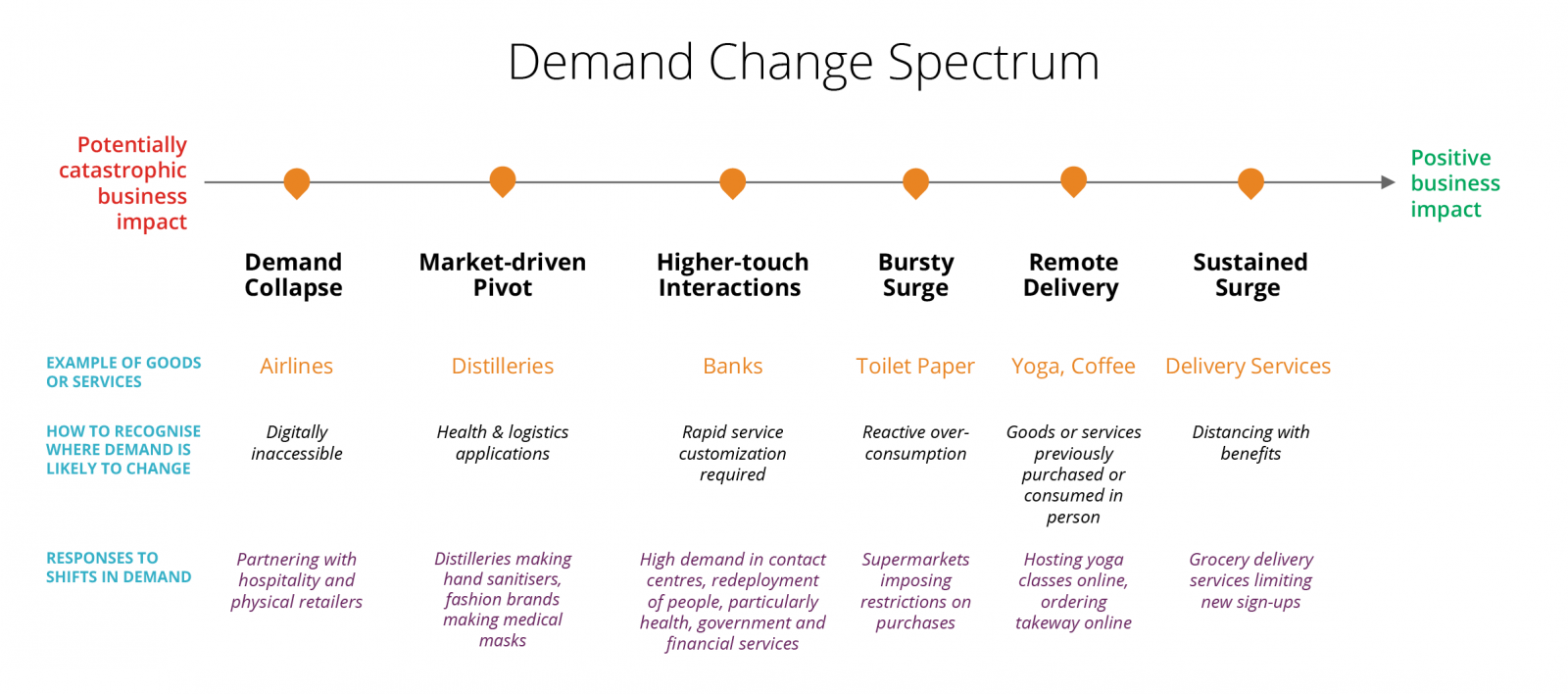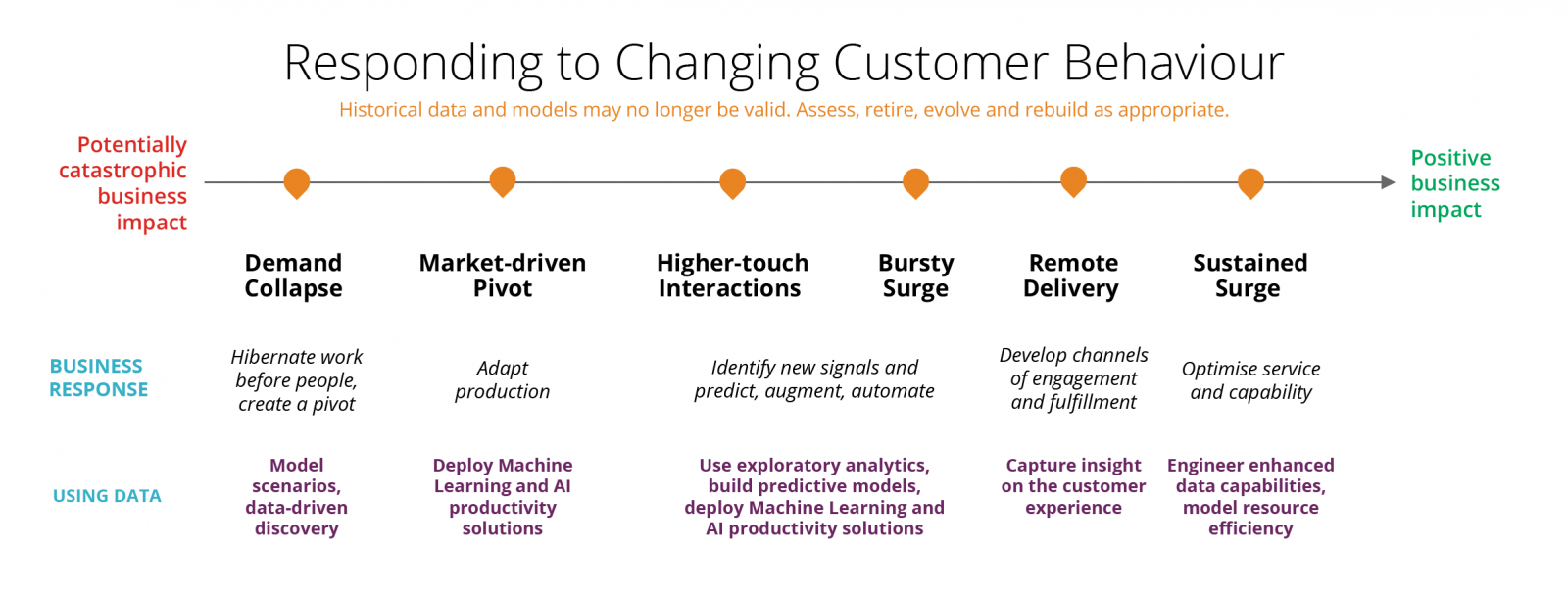
Data-driven responses to new patterns of customer behaviour
Using data effectively will be critical to navigating responses in this fast-evolving landscape. Organizations need to think about shifting ‘forward’ to the current reality and meet changing customer needs, but also be ready to shift ‘back’ as public health and economic stimulus measures are reduced to return to something like the historical norm. Even the organizations seeing positive shifts in demand have opportunities to use data more effectively through this period and beyond.
We’ll discuss the range of changes we’re seeing in customer demand, how those changes are driving a redeployment of people throughout organizations, and the consequent issues to consider in designing responses. Then, we’ll discuss the range of data-driven responses to these scenarios, including techniques and solutions, with some examples.

Changes in Customer Demand
We are now in a world with hard borders and distancing rules, where high-end fashion retailers make medical gowns, artisanal gin distillers produce hand sanitisers, and hotels run as quarantine facilities, but still, life goes on. Organizations that can respond to the shifts in customer demand will go on too.These market pivots sit on a broad spectrum of customer demand changes, from a total cessation of business - like airlines have faced - to massive surges in demand - such as supermarkets unable to fulfill online orders. In between, we see organizations responding to an increase in high-touch interactions with customers, such as banks being inundated with requests for mortgage assistance, or a shift to different channels of engagement and fulfillment including remote delivery of services and goods.
But organizations are probably not facing just one of these scenarios, but multiple scenarios at any one time, and a mix that is likely to evolve over time too. Whatever the mix, being able to recognise the nature of demand change is key to responding effectively. We have found it helpful to arrange these demand changes on a spectrum, from potentially catastrophic business impact, to positive business impact. This provides some guidance on how to improve outcomes, and how to avoid still worse outcomes. We have mapped out the spectrum below, with characteristics and examples of each scenario.

Mass Redeployments of People
The most immediate response we’re observing to shifts in demand is mass redeployments of people, within and between organizations. These might be driven by any demand change scenario, for instance: airlines collaborating with retailers to share capability, technology organizations creating platforms for people to move between jobs, and a vacuum cleaner manufacturer increasing headcount to make ventilators.With mass movements of people into new roles comes an enormous demand for solutions that enable people to do new and more complex tasks, provide faster service to more consumers, develop effective feedback loops, and help organizations continue to adapt to changing circumstances. Well designed data-driven solutions can be particularly effective in enabling and scaling the work people do, as we’ll explore in the responses below. However, for data-driven solutions to be effective, organizations must also consider further issues, as below.
Consequent Issues
Well-designed responses must consider more than external demand changes alone. First, organizations need to be able to look inwards and make tough decisions on how they should operate. The world today is different, and organizations need to be too. The sheer pace of change reinforces the digital transformation imperative of being able to rapidly prioritise and make decisions at speed, as well as the ability to quickly execute across historic functional boundaries.For demand collapse or market-driven pivot scenarios, organizations will additionally need to explore a range of possible futures, considering how long the disruption will last, how quickly demand will recover, and what trajectory it will follow. Organizations migrating demand to digital channels to support remote delivery and responding to a sustained surge in demand will also need to consider a range of possible futures, however from the reverse perspective.
High-touch interactions and bursty surges take established organizations into unknown territory. These organizations have built up historical data and know-how that has likely been invalidated by recent events. In simple terms, machines have been trained to behave like humans, and when humans do not behave as expected, neither do the models created to support them.
In fact, existing models and historical data may do more harm than good. We have seen some organizations struggle to process and keep up with alerts triggered by unexpected transaction volumes. Further, a rise in high-touch interactions may be a signal for an impending decline in demand or collapse. Finally, bursty surges in demand, such as panic buying toilet paper, are better avoided; they require additional resources to manage and have upstream and downstream impacts.
Considering the demand change spectrum, redeployment of people, and consequent issues, we’ve identified effective data-driven responses organizations should consider.
Data-Driven Responses

Demand Collapse
When in hibernation, organizations need to look through a lens primarily of what work should be paused, and where people can be redeployed. The longer they can retain capacity, the more likely they’ll be able to adopt other responses.
Data should be used to drive modelling of scenarios. While modelling inputs and assumptions may be far from precise in response to COVID-19, the modelling process is still valuable. Modelling socialises assumptions and exposes sensitivities, allowing organizations to collaboratively explore multiple potential futures, as demonstrated in this Australian electricity sector model.
Market Pivot
Data-driven discovery, such as market clustering analysis, can reveal potential pivots, especially when paired with qualitative techniques like user research. Machine Learning and AI solutions can be used to quickly adapt to new market conditions. Here, adapting means reorganising the basic building blocks of producing goods or services, in order to meet the changes in demand for a new market.
People are flexible and machines are scalable, so adapting means finding the right mix of automation, augmentation, and enablement: automation of high-volume or high-velocity judgement tasks (e.g. decisions involved in approving a loan or claim), augmentation for scaling high-value judgement tasks (e.g. decisions involved in providing great customer service), and enablement to share best practices. For example, we have worked with clients to augment teams with machine-vision-based quality assurance solutions. Starting simple and evolving solutions ensures the best fit and earliest value realization.
High-touch Interactions
Using data to assess high volume and high-touch interactions has never been more important. Being able to quickly ascertain what type of demand is being sought will enable organizations to understand how they can service these volumes quickly and potentially reduce non-value creating tasks through proactive automation. For example, banks can proactively identify customers who may be approaching financial distress and in turn proactively offer services to help customers through this time.
Chatbots are increasingly used to augment front-line staff while providing a natural interface for common queries. This in turn frees up people to focus on higher value work that requires more complex judgement.
Bursty Surges
The call to ‘flatten the curve’ applies here too. Electricity markets are a mature example of managing sometimes volatile fluctuations in demand. The combination of many data sources helps predict and understand which interventions will help avoid or smoothen the surges. At the limits of demand management, electricity markets also respond with additional capacity. Again, consider Machine Learning and AI solutions to create more capacity to respond.
Remote Delivery
It seems like every household right now is participating in some form of remote delivery. Children taking remote dance classes and karate lessons, people purchasing items online in volumes never before seen, and even socialising over video-conferencing parties.
It's certainly easier for organizations with developed digital channels to quickly respond to current conditions, but there is good news for those with underdeveloped channels, as mature partner ecosystems are available: social media channels, digital shopfronts and delivery services. Data will help you maintain your customer relationships through these new channels of engagement and fulfillment, and ensure your physical customer experience translates faithfully to digital.
Sustained Surge
When organizations are experiencing a new and sustained pattern of demand, this is a great opportunity for further investment in the resilience and scalability of underlying systems. Assessing current technical architectures and making plans to move to modern data architectures may provide a step change in both data integration capabilities as well as an opportunity to double down on advanced analytics capabilities.
Scaling advanced analytics capabilities will enable more parts of your organization to derive insight from complex data and, with real time data agility, take meaningful and timely action for your customers. Supporting practices like Continuous Delivery for ML models will help create an ecosystem for sustained growth beyond our current conditions.
Summary
We’re seeing a wide range of effects across organizations, driven by different dimensions of changing customer demand. The common factor, however, is that every organization is dealing with unprecedented changes. We have no choice but to be resourceful, think on our feet, and use the environment available to us, much like the pioneers of old.
Organizations need to be able to respond quickly, make decisions at lightning speed, and execute in ways they have never had to before. Data and ML/AI solutions need to be part of the plan in order to respond, decide and execute in the now, in order to be ready for the future.
Solutions that can be built iteratively and in a connected fashion across the various demand change scenarios, will help organizations move fast and effectively and arrive on the other side in good shape.
Disclaimer: The statements and opinions expressed in this article are those of the author(s) and do not necessarily reflect the positions of Thoughtworks.

















